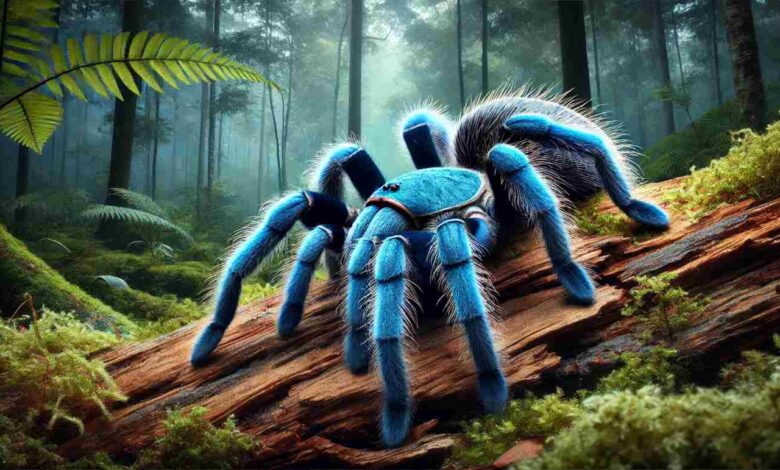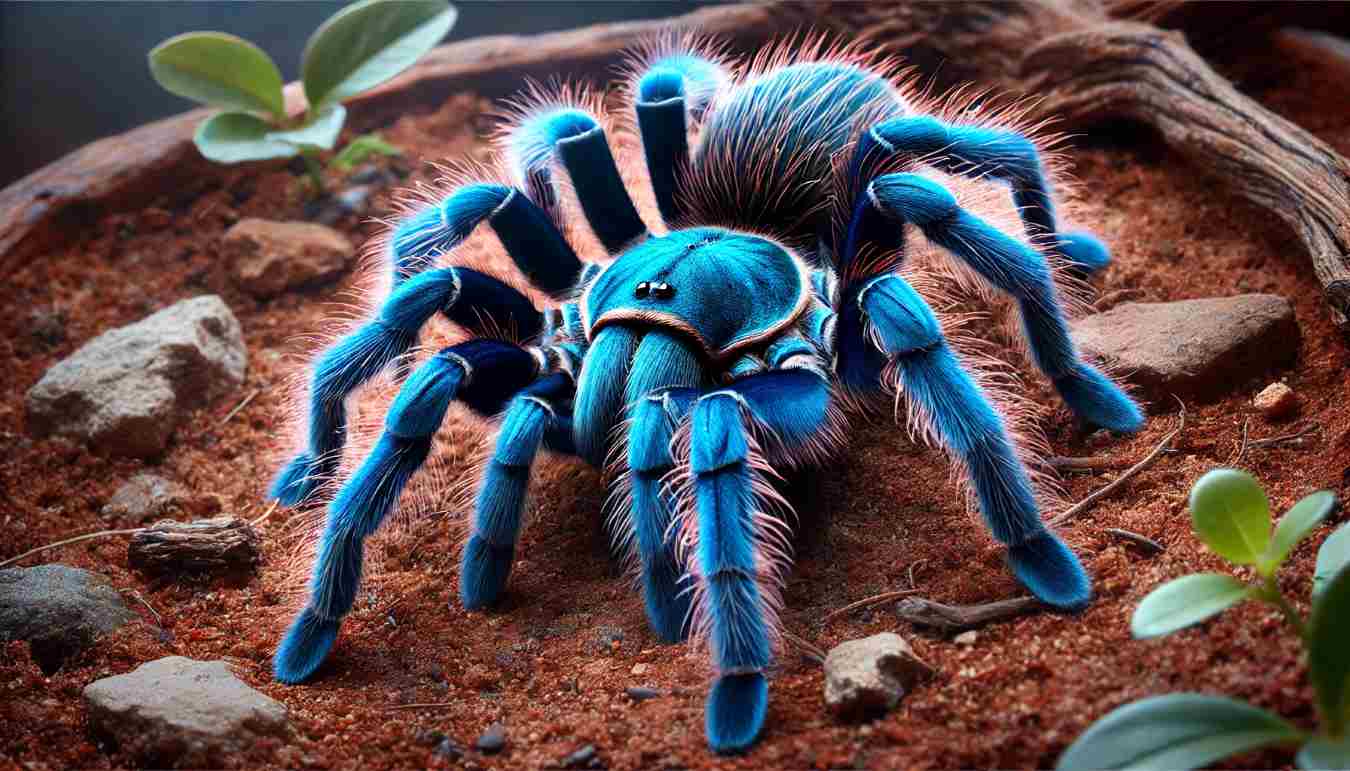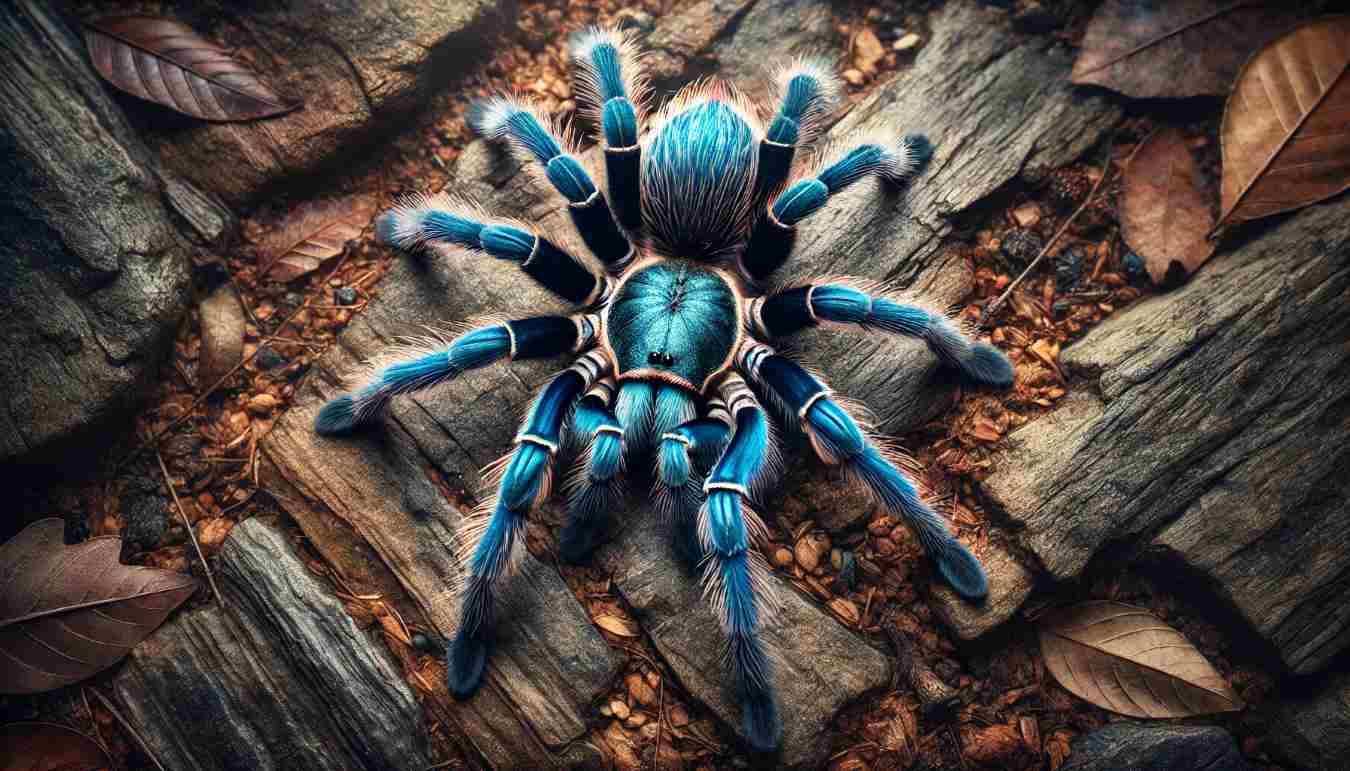Cobalt Blue Tarantula – Cyriopagopus lividus Spider

The Cobalt Blue Tarantula (scientifically known as Cyriopagopus lividus) is one of the most striking species in the tarantula family due to its brilliant blue legs and fascinating behaviors. Native to the tropical rainforests of Southeast Asia, particularly in Myanmar and Thailand, this tarantula has become popular among enthusiasts for its vibrant appearance and unique care requirements. However, it’s known for its defensive nature, making it less suitable for beginner tarantula keepers
Appearance and Identification
The Cobalt Blue Tarantula is highly prized for that gorgeous shimmering blue legs contrasting the spider’s pale gray or tan body. The bright blue is brightest shown when seen close, and females tend to be slightly larger than males.
Medium in size, with a leg span of about 5 inches, they also have dark chevron patterns on their body, making them quite distinctive. Its coloration helps the spider blend in with the shadowed depths of its burrows, offering a mix of camouflage and beauty.
Natural Habitat and Burrowing Behavior
Cobalt Blue Tarantulas are rainforest creatures, fossorial burrowers and are generally very prolific in the wild when they have optimal environmental conditions. The burrows offer them a safe place to hide from predators and keep them in an environment with the correct temperature and humidity.
The species is primarily fossorial, depending heavily on its environment for survival and rarely leaving their burrow except to capture prey.
For tarantulas in the wild, to keep them is to almost entirely allow this burrow lifestyle. They like to burrow and create a little territory, so tanks of 7-8 inches with substrate will make them feel comfortable. This tarantula species flourishes in incredibly high humidity (nearer to 75-80%) and temperatures sitting between 77-85°F, which closely represents their tropical abode.

Diet and Feeding Habits
She added that these tarantulas are nocturnal predators. Insects such as crickets, cockroaches, and mealworms make up their diet. Sometimes, they even eat small mammals or other tarantulas. They mostly stun these in the wild with their potent fangs, then carry them back to their burrow to consume at leisure.
If held in captivity, the prey should be gut-loaded (fed) before being given to the tarantula. Adults should be fed roughly once a week, with smaller, more frequent meals for younger spiderlings. When it comes to molting, you should not feed your tarantula, as this may leave it vulnerable.
Molting and Growth
The Cobalt Blue Tarantula, as with all tarantulas, undergo molting, where it sheds its exoskeleton to grow bigger. It happens more often with a young spider, and it slows down as the tarantula gets older. A tarantula that is molting is in an extremely vulnerable situation because of its exoskeleton remaining soft until the next period. Right care is necessary, humid environment managing, sound free environment to provide.
Temperament and Defense Mechanisms
The Cobalt Blue Tarantula has a reputation for its aggression. Fast and jittery, the kangaroo rat is one of those small species that sits its ground if it feels threatened – aggressively sometimes. Instead of egressing, it might rear up on its hind legs and show its teeth a precursor to biting.
Despite being not toxic enough to be fatal for humans, a bite can still inflict intense pain which sometimes is accompanied by muscle cramps, swelling, and severe allergic reactions in humans.
Due to this defensive nature, experienced tarantula keepers are the only ones that should be managing or housing this particular type of spider. While they are attractive to look at, they do not tolerate handling very well, and excessive disturbance can stress the spider.

Lifespan and Reproduction
Lifespan and Reproduction Female Cobalt Blue Tarantulas are remarkable in terms of lifespan, often living 20-25 years in captivity, while males typically live up to only 10-12 years. Mating is a more intricate process, with the male performing a courtship display to attract the female. After mating, the female can lay 100-1000 eggs, which she guards until the spiderlings hatch.
Keeping Cobalt Blue Tarantulas as Pets
Cobalt Blue Tarantula as a Pet Due to their striking coloration, Cobalt Blue Tarantulas are very attractive to hobbyists, but their aggressive nature makes them unsuitable for beginners. They require special care, including a well-ventilated enclosure, dense substrate for burrowing, high humidity, and controlled temperatures. It is also essential to provide hiding spots like cork bark or commercial hides to ensure the tarantula feels secure.
When setting up a terrarium, substrates such as coco coir or peat moss help maintain humidity and provide a good burrowing medium. Keep them comfortable by providing a minimum of 8 inches of substrate, since they are burrowers.
Conservation Status and Threats
Deforestation threatens the cobalt blue tarantula with habitat loss in its native southeastern Asia rainforest, even though it is not an endangered species. They are trapped for the pet trade, thus affecting them also in their natural habitat. Any responsible pet owner can help to take the pressure off wild populations by advocating for only purchasing reptiles from reputable breeders.
The Bottom Line
The Cobalt Blue Tarantula (Cyriopagopus lividus) is an amazing-looking species that possesses fascinating behaviors. Nevertheless, because they are so aggressive and have strict care requirements, it is ideal for a seasoned keeper. With its place in the ecosystem, vivid appearance, and long longevity, it’s no wonder it grabs the attention of thousands of tarantula fans worldwide. Like all exotics, understanding what they need is the key to successful care.





